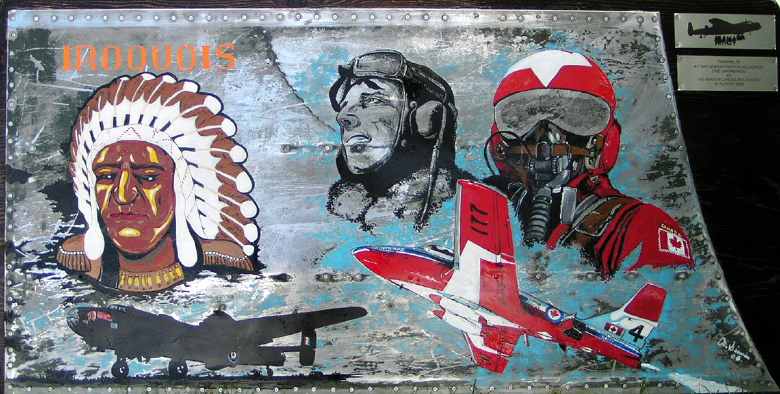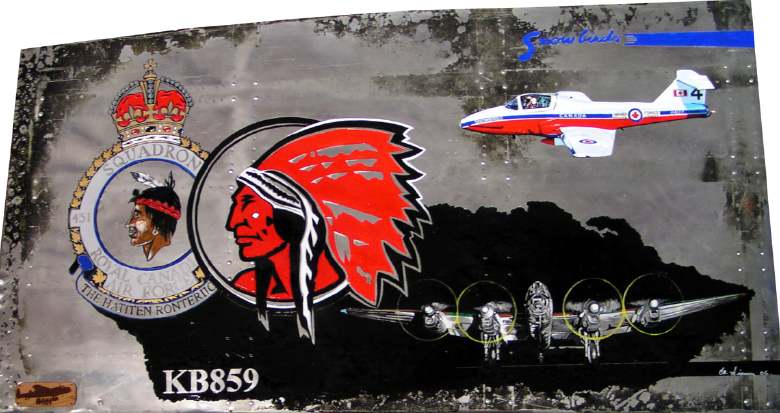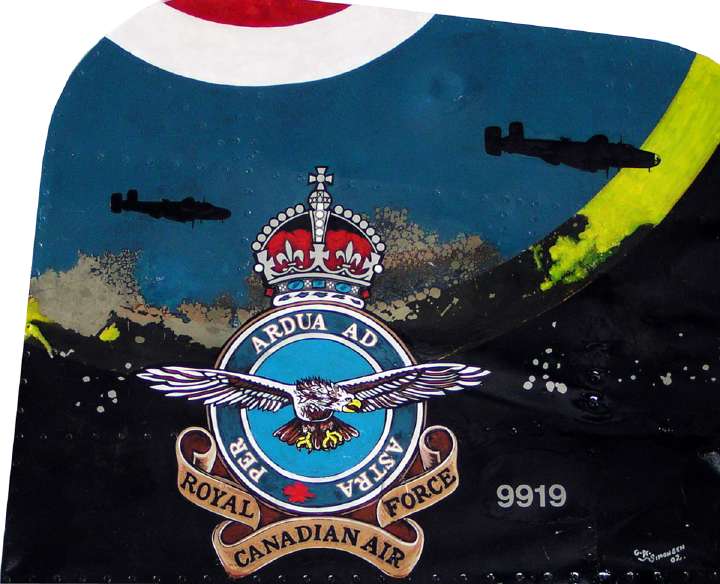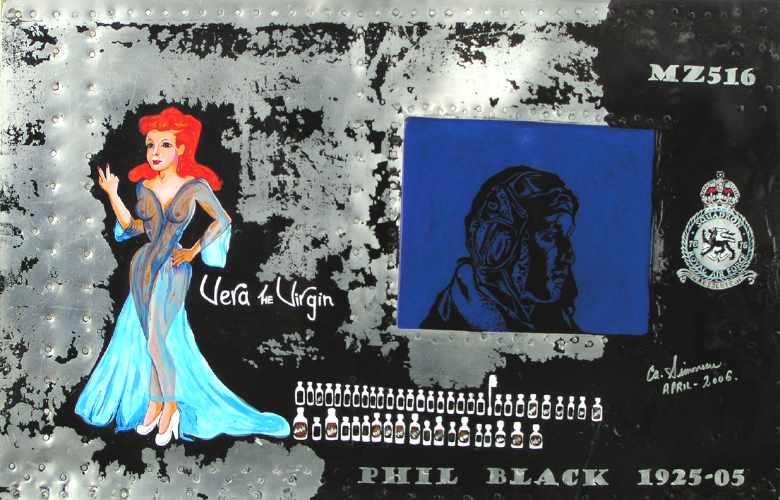 Nose Art
Nose Art  |
BCATP
|
Lancaster
|
Media
|
BCATP
|
Lancaster
|
Media
 Nose Art
Nose Art  |
BCATP
|
Lancaster
|
Media
|
BCATP
|
Lancaster
|
Media
Museum Collections
Clarence Simonsen Nose Art Collection
Nose Art

Clarence titled this panel, "The Three Faces of No. 431 Squadron". It was presented to No. 431 Air Demonstration Squadron (The Snowbirds) by the Nanton Lancaster Society at the 2006 Rocky Mountain House Airshow and commemorates the transferring of Tutor #177 from the Canadian Armed Forces to the Nanton Lancaster Air Museum. The aircraft flew with the Snowbirds for ten seasons.
No. 431's official badge was the head of an Iroquois Indian. During the course of the Second World War, the squadron flew Wellingtons, Halifaxes, and the Canadian-built Mk. X Lancasters.
The first face on the artwork is taken from the work of an unknown artist who in 1944 painted a 12'x12' image of an Iroquois Chief on the squadron's headquarters building at Croft with the words "The Home of the Iroquois" written below.
The second face is taken from a World War II Royal Air Force poster and represents the 367 airmen who were lost while serving with No. 431 Squadron during the war.
The third face honours the Canadian airmen who have flown with No. 431 Air Demonstration Team (The Snowbirds).
The artwork was painted on original skin from Halifax NA-337 that was recovered from Lake Mjosa, Norway in 1995 and which is now restored and on display at the RCAF Museum in Trenton, Ontario. Note the original green paint in the outer portions of the panel.

No. 431 Squadron RCAF was formed at Burn, Yorkshire, England during November 1942, their official badge being the head of an Iroquois Indian. The squadron transferred to the RCAF base at Croft in December 1943. During the course of the Second World War, No. 431 flew Wellingtons, Halifaxes and Canadian-built Mk. X Lancasters. No. 431 Squadron continues to serve as No. 431 Air Demonstration Squadron "The Snowbirds".
The panel portrays the history of No. 431, the images including the squadron's wartime crest, an Iroquois Chief that was carried on the nose of their aircraft, a Lancaster with serial number KB-859, and the museum's Tutor #177 in Snowbird #4 markings.
The panel was unveiled by Marg Liessens and Major Dan Robinson in 2006. Marg's father, P/O Albert Dorey, was lost while serving in Lancaster KB-859 with No. 431 Squadron. Major Robinson is the grandson of Howard Armstrong, one of the trio who purchased the museum's Lancaster in 1960. Dan Robinson grew up in Nanton prior to joining the Canadian Armed Forces. He flew Snowbird #4 during the 1996 and 1997 seasons. Clarence painted the artwork on original skin from a Canadian-built Lancaster.

Clarence painted this artwork to commemorate the 9,919 members of the Royal Canadian Air Force who were killed while serving with Bomber Command. Hundreds of other Canadians were lost while serving with the Royal Air Force. The RCAF's motto, "Per Ardua ad Astra", was the same as that of the Royal Air Force, and translates to "Through Adversity to the Stars".
Clarence painted his tribute to the 9919 airmen on the original escape hatch door from Halifax NA-337. During the night of 24 April 1945, the aircraft was struck by German flak as it flew over the railway bridge at the south end of Lake Mjosa in Norway. With the right wing on fire the crew had only one option -crash land in the frigid waters of the lake. Shortly before NA-337 hit the water, one of the crew removed the rear escape hatch door and it fell into the lake. Most likely it was F/Sgt. A. Taylor, the wireless operator/air gunner.
Fifty years later Halifax NA-337 was raised from 750 feet below the surface of Lake Mjosa by a team led by Canadian Karl Kjasgaard. The aircraft is now fully restored and on display at the Royal Canadian Air Force Museum in Trenton, Ontario. The aircraft's rear escape hatch was recovered from the lake bottom separate from the main fuselage.

In 2005, Dr. Phil Black of White Rock, British Columbia donated a 1:12 scale flying model of Halifax MZ-516 to the museum. Phil had flown in this aircraft as a navigator with No. 76 Squadron RAF. Marked "MP-V", it was known as "Vera the Virgin". While returning from a raid on Mainz and flying at 7000 feet over East Anglia, the starboard outer engine began vibrating. Attempts to feather the propeller were unsuccessful and with the situation deteriorating rapidly, the order to abandon was given. Three of the crewmembers were able to leave the Halifax before it crashed. This had been the aircraft's 77th operation.
Dr. Black attended the dedication of Canada's Bomber Command Memorial at the museum in 2005. Sadly, while returning home Phil and a friend were killed when the light aircraft they were flying aboard struck a mountain during bad weather. Clarence painted this artwork in memory of Phil who he had met at the dedication ceremony in Nanton. It is based on a wartime photo taken by Phil of the nose art carried by Halifax MZ-516.